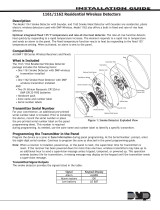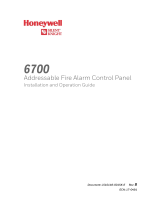Page is loading ...

© 2001 Interlogix B.V. All rights reserved 145207999-1 September 2001
560/570 Series Battery Powered
Wireless Smoke Detector
Installation Instructions

2
PRODUCT SUMMARY
The 560 / 570 Series battery powered smoke detectors offer two
solutions:
• 560 Series for stand-alone applications,
• 570 Series incorporating a tamper switch is for use with a
radio transmitter to a control panel.
The operation of the 560 / 570 Series detectors are identical
except for the silence and test:
• The 570 Series cannot be silenced using the Silence / Test
button.
• The 570 Series does not issue an alarm beep at the end of
a test sequence.
• The 570 Series will transmit a tamper fault when removed
from its base.
INSTALLING THE DETECTOR
In addition to the local Fire Protection Standards, use the
following location guidelines to optimise performance and reduce
the chance of false alarms from the detector:
• Locate ceiling-mounted smoke detectors in the centre of a
room or hallway at least 10 cm (4 inches) from any walls or
partitions.
• Locate wall-mounted smoke detectors so the top of the
detector is 10 –30 cm (4 to 12 inches) below the ceiling.
• Locate away from air conditioners, radiators and any other
ventilation sources that may interfere with smoke entering
the detector.
• DO NOT mount the detector on removable ceiling panels as
the removal of these panels will render the detector
inoperable.
To install a detector
1. If you are using the detector/base lock, remove the two
knockouts
on the mounting base. (See Figure )
2. Slide the battery compartment cover away from the detector
to unsnap it and lift it off. See Figure
:
Tab
Slot
Battery compartment
3. Observing proper polarity, insert two 3V-lithium batteries into
the detector battery compartment and replace the battery
compartment cover.
4. Remove the red plastic dust cover from the detector. The
detector is shipped with a dust cover for protection on
construction sites with dusty environments.
5. Using the two screws and anchors provided, mount the base.
6. Attach the detector to the mounting base as follows:
- Line up the raised tab on the lip of the detector with the
slot on the lip of the mounting base. (See Figure
)
- Insert the smoke detector into the base and turn
clockwise approximately 15 degrees. It should snap
firmly into place.
Important: The detector cannot be attached to the mounting
base if no batteries are installed.
7. Test the detector (See Smoke Testing the Detector).
SMOKE TESTING THE DETECTOR
Replace the batteries as described in Replacing the Batteries
below.
Test smoke detectors in place annually using canned aerosol
simulated smoke. Follow the instructions on the canned smoke.
The detector LED remains on and the alarm sounds a temporal
rhythm until the Test/Silence button is pressed. The detector
automatically resets when smoke is no longer present.
THE TEST/SILENCE BUTTON
The Test/Silence button on the detector performs these three
functions:
Testing: Press the Test/Silence button for 2 seconds. The
detector performs a sensitivity test and, in the case of the 560
Series, a sounder test.
Silence alarm (560 Series only): Press to silence the sounder
during an alarm. After a few minutes, the sounder and alarm
resume if smoke is still present.
Silence trouble chirp: Press to silence a trouble chirp. The
trouble chirp resumes after 24 hours if the trouble condition is not
corrected.
TESTING THE DETECTOR SENSITIVITY
The smoke detector provides a sensitivity level test mode that
allows you to check the smoke detector sensitivity using the
Test/Silence button and the LED indicator on the detector as
follows:
1. Press the Test/Silence button on the smoke detector for 2
seconds. Once the test starts, the alarm LED flashes one to
nine times.
2. Count the number of times the LED flashes and use the
following table to determine the status of the smoke detector
sensitivity and what action to take, if any.
Flashes Obscuration
%/m
(approx.)
Indication Action
1 N/A Unserviceable
hardware fault
detected
Reset the unit
and rerun
sensitivity test. If
the error
persists, replace
the unit.
2, 3 N/A Detector is not
sensitive
enough
Clean the unit.
Reset it and
rerun the
sensitivity test. If
the error
persists, replace
the unit.
4 0.95 %/m
5 0.79 %/m
6 0.64 %/m
7 0.49 %/m
Detector is
within normal
sensitivity
range
N/A
8, 9 N/A Detector is too
sensitive
Verify that the
smoke
chambers are
snapped down
correctly. Clean
the unit and
replace the
smoke chamber.
After the flashes, if the sensitivity is within limits and all
other tests pass, the 560 Series will go into alarm, sound its
sounder, and reset after 5 seconds; the 570 Series will
remain silent.
If the sensitivity is not within limits, or an unserviceable
hardware fault has been detected, the smoke detector LED
extinguishes until the detector is serviced.
REMOVING THE DETECTOR
To remove the detector from the mounting base, hold the
detector and turn it counter-clockwise approximately 15 degrees.
The smoke detector will snap out of the mounting base.
To remove the detector from the mounting base when the
detector/base lock is used, insert a small screwdriver into the
locking tab slot on the side of the base and press in while
simultaneously turning the detector counter-clockwise 15
degrees. (See Figure
)
UNDERSTANDING THE LED
The LED on the detector indicates the status of the detector as
follows:

3
FLASHING: Flashes every 9 seconds to indicate normal
operation.
ON: Detects smoke.
OFF: Trouble or maintenance is required.
REPLACING THE BATTERIES
The batteries should be replaced annually prior to annual smoke
test of the detectors OR if the Low Battery warning is sounded.
Always replace both batteries.
1. Remove the detector from the base as described in
Removing the Detector.
2. Open the battery compartment as described in Installing the
Detector.
3. Remove the batteries by pulling the red cloth tab.
4. Observing proper polarity, insert two 3V lithium batteries
into the detector battery compartment and replace the
battery compartment cover.
5. Attach the detector to its mounting base as described in
Installing the Detector.
6. Smoke test the detector as described above.
CLEANING THE DETECTOR
Clean the detector cover with a dry or damp (water) cloth as
needed to keep it free from dust and dirt. When necessary, clean
the detector interior and replace the smoke chamber as follows:
1. Remove the detector from its mounting base. (See Removing
the Detector)
2. Remove the batteries. (See Replacing the Batteries)
3. Slide a flat-blade screwdriver in the slot on the detector cap
and gently push the handle down to pry the cap up and off.
(See Figure
.)
4. Press in on the sides of the smoke chamber and pull it up
and away from the detector and discard. See Figure
:
Q Optical base
R Smoke chamber
S Indentation
T Optical chamber
U Sensor cap
5. Blow out or use a soft-bristled brush to remove dust and dirt
from the smoke chamber base.
6. Align the new smoke chamber up with the smoke chamber
base and snap down into place.
7. To replace the detector cap, replace the batteries, and re-
attach the sensor to the base, see Installing the Detector.
8. Test the sensitivity as described in Testing the Detector
Sensitivity.
MAINTAINING THE DETECTOR
The smoke detector should be tested weekly. (See Testing the
Detector Sensitivity and Smoke Testing the Detector.)
When a 560/570 Series detector fitted with a transmitter requires
maintenance, it extinguishes its LED and initiates the internal
signals described in the following table.
Signal Maintenance required
Clean Me Smoke detector sensitivity is out of
range and needs cleaning. See
Cleaning the Detector.
Maintenance alert Detector failed power self-test. Perform
a sensitivity test. See Testing the
Detector Sensitivity. If the problem
persists, replace the unit.
Low battery Batteries in the detector are low.
Replace them.
TECHNICAL SPECIFICATIONS
Voltage..............................................................................3 VDC
Battery life ................................................................ 1 year (min)
Battery type............ 3V Lithium, Duracell® DL123A or equivalent
Low battery threshold ...........................low battery signal at 2.7V
Sounder .......................................85 dB @ 3 m, temporal output
Colour ................................................................................ White
Operating humidity .................................. 0-95% non-condensing
Operating temperature ............................................ -5°C to 38°C
Detector dimensions ........................................... 14 cm x 5.6 cm
Base dimensions............................................ 12.3 cm x 0.95 cm
Sensitivity................................................................. 2.3%± 0.8%
Drift compensation adjustment .............................. 0.5%/ft. max.
ADDITIONAL RF572SW8 SPECIFICATIONS
Typical average standby current.........................................25mA
Typical test current ...............................................................2mA
Typical alarm current.......................................................... 70Ma
Low battery beep rate.............................1 every 30 sec. ± 2 sec.
RFI immunity................................. 20V/m minimum; 0-1000MHz
RF frequency.................................................................. 868MHz
Transmitter ID ......................... Pre-programmed, 1 Million codes
Modulation type............................................................ FM, FSK
Signal format .............................................Manchester Encoded
Signal types ..................... Alarm, Restore, Tamper, Low battery,
................ Trouble(maintenance/CleanMe ® ),1 hour supervisory
Approvals ............................................................................... CE
ADDITIONAL RF572SI4 SPECIFICATIONS
RF frequency.................................................................. 433MHz
Storage Temperatures ............................................ -34° to 60° C
ORDERING INFORMATION
Accessories
SM-200 Smoke! In a can (canned smoke) for
functional testing of detectors
SME-XT1 Extension tube for Smoke! in a can
211 Replacement smoke chambers (set of 10)
/


